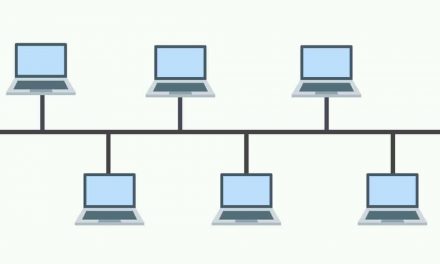In the simplest way, a network topology is the configuration of a communication network. Some can define network topology as the geometric depiction of the way computers are linked in a computer network. In this article we shall be exploring the common types of network topology. We shall also be evaluating to see their upsides and their downsides. As usual we shall also be highlighting other relevant information you might need to know about network topologies.
Table of Contents
Mesh Topology
Just as the term ‘mesh’ suggests each and every computer in the network is linked every other computer in the same network. Essentially this means that a connection that one computer has to another is solely for those two computers. Each connection caters for communication strictly between the two computers in question. This means that the more the number of computers in the network the more the links or connections will be. Consider a network that has 10 computers. This would mean that every one of those computers will have 9 connections to each of the respective 9 computers in the network.
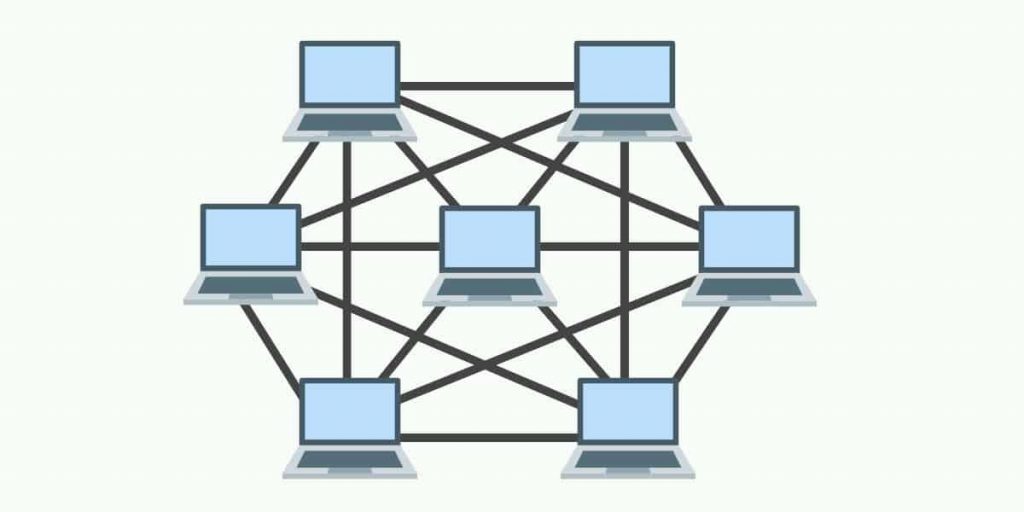
Mesh Network Topology
Advantages of Mesh Network Topology
The mesh network topology comes with the great convenience of not having communication conflicts. Remember we said that a connection or link is solely for communication with the connected computer. Thus it is not possible for data to go where it is not supposed to go. This can be a thing for confidential communication or the transmission of highly sensitive information. This even shows you that security can be maintained quite well. In the event that one particular link or connection goes down, it will not affect the other connection. This is akin to isolating a problem so that it does not affect the others. Audit trails and troubleshooting is also easy in this type of setup.
- Easy to diagnose faults
- It’s a secure network topology as it is a point to point link, preventing unauthorised access
- Mesh network topology is very robust
- Every connection of the mesh network can carry it’s own data load
- Failure on one link in the mesh network does not the other links
Disadvantages of Mesh Network Topology
Just by looking at the mesh network topology you can realise that there can be some issues. One, there are numerous connections involved which can be very complex to handle. There is only a certain number of connections that a computer can accommodate. This means that at some point you really cannot add any more computers to the network. This would be a great setback if you want to expand the network.
- It’s difficult to install and configure a mesh network topology
- It’s expensive as all the nodes in the network have to be connected to each other by the cables
- You can only connect a limited number of computers, thus difficult to scale the network
Star Topology
In the star topology the computers in the network are only connected to a central point. That central point is called a hub. This means that communications between computers are facilitated or handled by the hub. It is more like having a mediator (i.e. the hub) to enable communication between two computers. Suppose computer A wants to send a message to computer B. Computer A will first of all send the message to the hub and the hub will then send the message to computer B. If computer B responds it will send the message to the hub again and the hub sends it to computer A. There is absolutely no direct interaction between the computers in the star topology.

Star Network Topology
Advantages of Star Network Topology
There are of course fewer hassles in setting up plus it is also much cheaper to set up. This is because the expertise and the equipment needed (e.g. cabling) is less sophisticated and cheaper. Much easier to run and maintain – especially because if one connection goes down it does not affect the other connections. Again audit trails and troubleshooting is much easier to do.
- Fast network performance due to low network traffic
- The star network topology can easily be upgraded as and when required
- It’s easy to troubleshoot problems in the star network topology
- Failed nodes can easily be replaced without affecting the other network nodes
- It’s easier to install a star topology
Disadvantages of Star Network Topology
The hub obviously needs lots of attention in terms of maintenance. Transmission of data can be somewhat slower given that everything has to go through the hub. That centralization can be a problem especially if the hub experiences down time for some reason.
- If the hub fails, the whole network stops as all the nodes are dependent on the central hub
- The hub requires more resources and maintenance
- Performance of the whole network is dependent on the capacity of the hub
- It’s expensive to install and maintain a start network topology.
Bus Topology
To better understand this, just think of the setup of a bus. A bus has a corridor and every seat is linked to the corridor. In the bus topology there is one main line or cable. Each and every computer in the network is connected to the main line. The cable that links an individual computer to the main line is called a drop line. The bus topology is as simple as that.
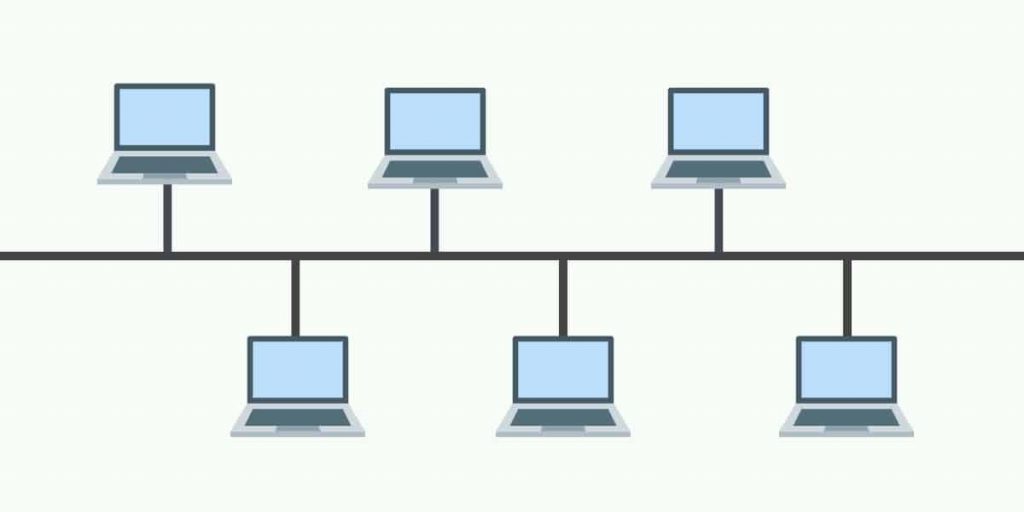
Bus Network Topology
Advantages of Bus Network Topology
Overall the setup is easy and inexpensive. This obviously stems from less equipment needed for the setup.
- Easy to expand by linking the cables together
- Less cables required for the bus network topology compared to other network topology
- It’s a simple network topology, not complex
- It’s a cost effective/inexpensive network topology
Disadvantages of Bus Network Topology
There two main downsides of the bus topology. There are only a particular number of computers that can be connected here. This can be a huge blow for when you want to expand the network. Unlike the previous topologies, audit trails and troubleshooting can be an uphill task here.
- It’s difficult to expand as there is a limited numbers of nodes you can connect to the main cable
- Difficult to detect faults in a bus network topology
- If the main cable collapses, the whole network will collapse
- Reduced network performance if there are many nodes and high network traffic
- Slower network performance compared to he ring and star topology.
Ring Topology
In this type of topology a computer has two connections to it. This shows you that every computer in that network has two computers connected to it – on either side. Picture a ring with computers along its circumference – that is the ring topology. You might be wondering how a computer sends data if it is meant for a computer that it is not directly connected to. Well, that is where repeaters come in – they are incorporated on every computer. Thus data in the scenario we just highlighted will be passed on till it reaches its intended recipient computer. That element of passing it on is done by the repeaters.
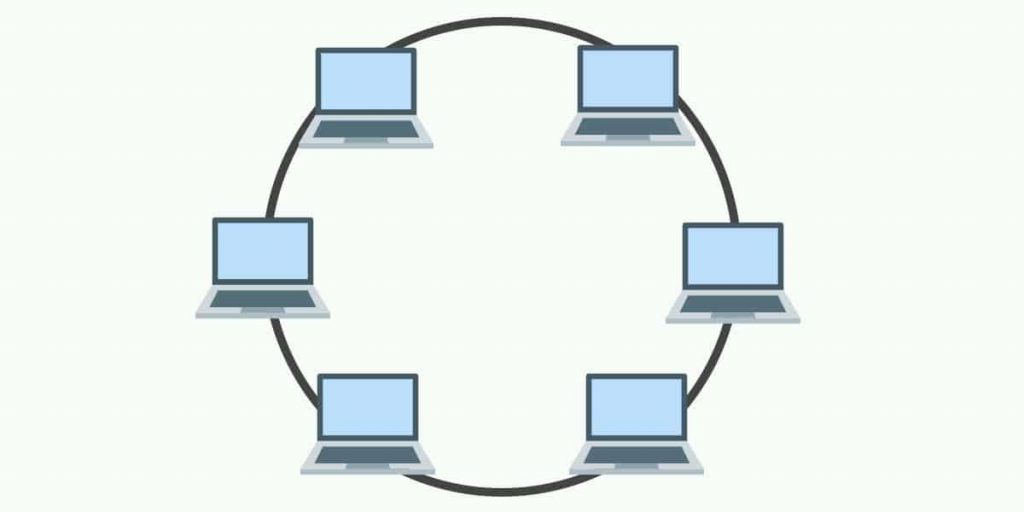
Ring Network Topology
Advantages of Ring Network Topology
Setting up, running and maintenance are so easy to do.
- Ring network topology is cheap to install and expand
- Easy to install
- Fast network performance as data can move through the nodes at high speed
Disadvantages of Ring Network Topology
Transmission of data can be problematic especially considering that it can first of all get to computers where it is not intended. Unauthorized access can occur due to this. Distortions or even loss of data integrity can occur due to this setup. In the event that one connection goes down, the whole network is affected – isolating that one problem area is not possible.
- Difficult to troubleshoot problems in a ring network topology
- Difficult to add or removed nodes as this will interrupt the activities of the network
- If one node/computer fails, the whole network will fail
- As more devices are added to the network, the more communication delay the network experiences
Hybrid Topology
This is quite simple to grasp – just consider the term ‘hybrid’. This type of topology involves connecting 2 or more different network topology eg connecting a star network topology with a ring network topology. The obvious downside of this revolves around setting up and troubleshooting – it can be very complicated. One of the key advantages is the ability to easily expand the network.
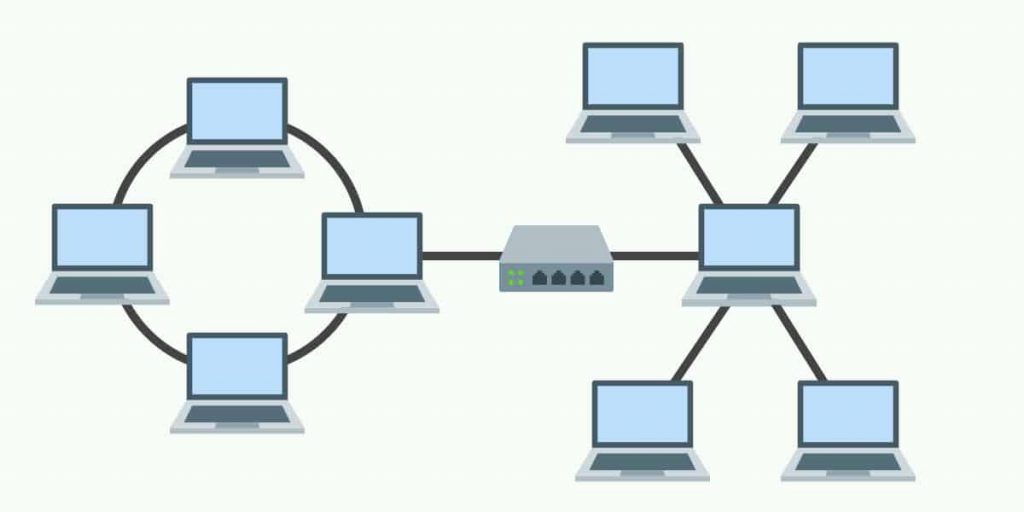
Hybrid Network Topology
Advantages of Hybrid Network Topology
- Can easily be expanded/scaled
- It’s flexible as you can incorporate multiple different topologies
Disadvantages of Hybrid Network Topology
- It can be very complex
- Setting up a hybrid network topology can be expensive
- High maintenance costs
- Can be difficult to troubleshoot faults
These are the 5 core types of network topologies used in computer networks.


